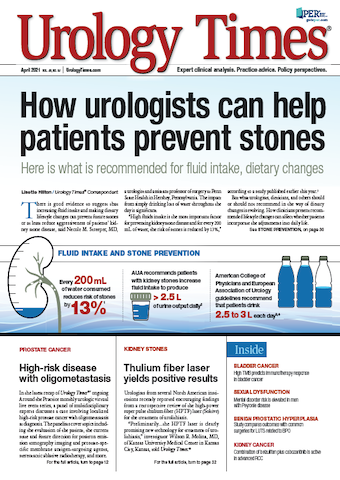Publication
Article
Urology Times Journal
Relapse rates not higher with RARC versus open radical cystectomy
Author(s):
Disease stage and adverse features were the main predictors of relapses and survival after robot-assisted radical cystectomy.
Recurrence rates and patterns with robot-assisted radical cystectomy (RARC) were similar to historical data reported for open radical cystectomy in patients with bladder cancer, according to a large retrospective database analysis.1
The study reviewed data for 2107 patients who had received RARP. At a median follow-up of 26 months (IQR, 11-55), 521 (25%) of the 2107 patients had disease relapse. Distant metastases occurred in 18% of patients and local recurrences were reported in 11% of patients.
The investigators observed that worse relapse-free, local recurrence–free, distant metastasis–free, and overall survival occurred in patients with higher disease stage, positive lymph nodes, and positive soft tissue surgical margins (log rank P <.01 for all comparisons). Additionally, statistical analysis showed that disease stage (≥pT3) and node positive status had a significant association with relapse-free, local recurrence–free, distant metastasis–free, and overall survival (P <.01).
“Disease stage remains the main variable associated with disease relapse and survival following radical cystectomy. Robot-assisted radical cystectomy was not associated with different patterns or higher relapse rates compared to historic open radical cystectomy data,” the authors wrote.
The 2107 patients for the analysis were identified from the International Robotic Cystectomy Consortium (IRCC) database.
Across the overall population, the mean age at cystectomy was 68 years, 76% were male, and the mean Body Mass Index was 28. Nearly half (47%) of patients had prior abdominal/pelvic surgery, 7% had prior irradiation, and 11% had a clinical T stage that was cT3 or higher. Twenty-two percent of patients had received neoadjuvant chemotherapy, 60% had intracorporeal urinary diversion, and 80% had ileal conduit diversion.
Additionally, surgery led to significant blood loss (>500 ml) in 28% of patients, blood transfusion in 8%, high-grade complications in 28%, and readmission in 36%. Six percent of patients had positive surgical margins. Adjuvant therapy was received by 18% of patients.
The most frequently reported site of local recurrence was the pelvis. The most common site of distant metastasis was the lungs (6%) and extrapelvic lymph nodes (5%). Peritoneal carcinomatosis and abdominal wall/port site metastasis each occurred in 1.2% of patients.
The 5-year relapse-free survival rate was 66% and the 5-year local recurrence–free survival rate was 84%. The 5-year distant metastasis–free survival and overall survival rates were 74% and 60%, respectively.
The researchers did not note a significant difference between these rates and historical data for open radical cystectomy.
Several limitations to the research were listed in the paper, including the retrospective nature of the analysis, the heterogeneity of the patients/physicians/protocols among the cases in the IRCC database, insufficient data available (eg, variant histology), and the lack of a comparative open radical cystectomy cohort.
In their conclusion, the authors wrote, “RARC does not seem to exhibit a different relapse pattern compared to the ORC literature. Disease stage and adverse features remain the main predictors of relapses and survival after RARC.”
Reference
1. Elsayed AS, Gibson S, Jing Z, et al. Rates and Patterns of Recurrences and Survival Outcomes after Robot-Assisted Radical Cystectomy: Results from the International Robotic Cystectomy Consortium. J Urol. 2021;205(2):407-413. doi: 10.1097/JU.0000000000001380

Newsletter
Stay current with the latest urology news and practice-changing insights — sign up now for the essential updates every urologist needs.



























